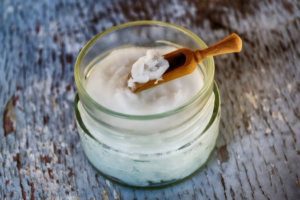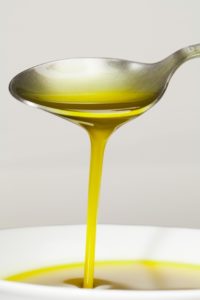We hope you love the products we recommend! Just so you know, Trendy Mami may collect a share of sales or other compensations from the links on this page.
–
Did you know that you can possibly have whiter teeth and get rid of bad breath if you swish some oil in your mouth for a period of time? It sounds a little odd and even gross, but many people swear by it. The process is called oil pulling, and it’s a holistic dental treatment that has been catching on lately.
Many have been doing oil pulling as an added step to their daily oral hygiene routine. But what is it? Read on and find out.
And if you are going to try out this unique technique, make sure you’re using quality oils. Check out California Olive Ranch for tons of great oil options.

What is Oil Pulling?
Oil pulling is an ancient Ayurvedic dental treatment that apparently dates back about 3,000 years. It basically involves swishing a small amount of oil in your mouth for a short time, then spitting it out. The idea is that the oil pulls out bacteria and other toxins that hide within your mouth.

How Does Oil Pulling Work?
When you get up in the morning, get a tablespoon of any oil and swish it around your mouth for about 20 minutes, like when you use mouthwash. However, don’t do it as vigorously since you’ll be doing it for far longer and your jaw will get tired.
Gently swirl the oil around your mouth and suck it through the spaces between your teeth. Make sure not to swallow any of it, or you’ll ingest the nasty things in your mouth collected by the oil.
When you’re finished, spit the oil in the trash. Don’t spit it in the sink because when the oil congeals, it may clog up your pipes. Rinse your mouth out with warm water then brush and floss like normal.

What are Some Tips to Oil Pulling?
- Although sesame oil has traditionally been the oil of choice, just about any plant-based oil will do, including sunflower and olive oil. However, many people prefer using coconut oil, not just because it tastes better than other oils, but also because it has more health benefits.

- If the thought of swishing a tablespoon of oil for 20 minutes sounds difficult, take things slowly. For example, try a teaspoon instead and do it for only five minutes for the first few days. Then where you’re used to that, try a little more oil, or increase the duration.
- Some people may not like the texture of congealed coconut oil in their mouth. If you’re one of those people, heat the oil in the microwave for a few seconds to melt it (but obviously not hot enough to burn your mouth).

What are the Benefits to Oil Pulling?
Oil pulling has been attributed to a number of benefits that include whiter teeth, healthier gums, clearer sinuses, stronger jaw, and a decrease in bad breath and gingivitis.
It’s important to keep in mind that oil pulling is not meant to replace regular dental hygiene. You still need to brush, floss at least twice a day and visit your dentist twice a year.

Are there Side Effects to Oil Pulling?
Most of the side effects of oil pulling are not harmful, but instead cause discomfort. These are caused by improperly swishing the oil, or accidentally ingesting some of it. They include an overly dry mouth, upset stomach, nausea, and a stiff jaw.
The biggest concern regarding improper oil pulling is lipoid pneumonia, in which the person may accidentally inhale the dirty oil, which can enter the lungs and cause inflammation.

Does Oil Pulling Actually Work?
Although there is a lot of anecdotal evidence extolling the virtues of oil pulling, there is no scientific evidence supporting that it actually works. Some studies have been conducted on oil pulling, but most of the results have been inconclusive.

If you’re still interested in trying oil pulling, there’s no harm in giving it a try. Just make sure that you do it properly and you’re still maintaining proper dental hygiene.
If you can’t stand the taste of oil, which many can’t there are other ways of whitening your teeth. Check out our article on 4 different ways to brighten your smile!












